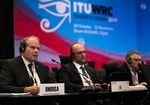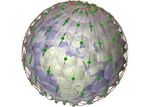The World Radiocommunication Conferences 2019 and 2023 - Key Outcomes for Space Services - unoosa
←
→
Page content transcription
If your browser does not render page correctly, please read the page content below
The World Radiocommunication Conferences 2019 and 2023
Key Outcomes for Space Services
Presentation to the STSC 57th
February 2020, Vienna, Austria
Véronique GLAUDE
veronique.glaude@itu.int
ITU Satellite Expert
BR Space Services DepartmentUNOOSA Statement to the 5 th Plenary Meeting
by Mr Niklas Hedman, Chief of the Committee, Policy and Legal Affairs Section
- Common commitment to building capacity for all Member States, especially
developing countries and States that have recently joined the space
community;
- Continue their fruitful cooperation in the years to come.
STSC 57 2020 – ITU V. Glaude 3Gender Declaration
WRC-19 declared
the commitment of the Sector
to gender equality and gender balance.
4WRC-19 agenda items
a.i. 1.6 New constellations; New regulations
a.i. 7 issue A Mission’s constellations milestones
a.i. 1.7 Multiplication of small satellites
a.i 7 issue M Short duration missions
a.i. 1.4 New orbital slots opened up for broadcasting satellites
with a priority mechanism for developing countries
a.i 7 issue E Special procedure to provide priority to fixed satellite services
STSC 57 2020 – ITU V. Glaude 5For new non-GSO constellations using the
50/40 GHz frequency bands - WRC-19 a.i. 1.6
WRC-19 developed a new regulatory framework (technical, operational
and regulatory)
Ensuring compatibility and protection needed with systems already
using the bands:
- GSO fixed-satellite services (FSS)
- broadcasting-satellite service (BSS)
- mobile-satellite service (MSS)
Using aggregate and single-entry link degradation limits produced at
any point in the GSO by emissions from all the earth stations of a non-
GSO system in the fixed-satellite service or into any geostationary FSS
earth station
STSC 57 2020 – ITU V. Glaude 6➔Why is WRC-19 a.i. 1.6 important?
Advances in satellite design, manufacturing and launch service
capabilities have enabled the deployment of non-GSO FSS
constellations.
Additionally, the advances in antenna and terminal technology have
enabled the development of the 50/40 GHz frequency bands for both
GSO FSS/BSS and non-GSO FSS.
The new framework creates certainty among potential operators of
non-GSO satellite systems in these bands.
STSC 57 2020 – ITU V. Glaude 7Members agree to new milestones for
non-geostationary satellite deployment- WRC-19 a.i. 7(A)
After the end of the current regulatory period for bringing into use,
the constellation deployment will have to be of minimum:
10% within 2 years,
50% within 5 years, and
100% completely deployed within 7 years.
STSC 57 2020 – ITU V. Glaude 8➔Why is WRC-19 a.i. 7(A) important?
It ensures that the Master International Frequency Register reasonably
reflects the actual deployment of such NGSO satellite systems.
Ensuring a negotiated balance between :
• the prevention of radio-frequency spectrum warehousing,
• the proper functioning of coordination mechanisms, and
• the operational requirements related to the deployment of NGSO systems.
Further studies by ITU required on:
• tolerances for certain orbital characteristics of NGSO space stations, and
• for the possible development of post-milestone procedures.
STSC 57 2020 – ITU V. Glaude 9Short duration mission special needs
- WRC-19 a.i. 1.7
Definition = small satellites with a limited period of validity
WRC-19 allocated the spectrum needs for telemetry, tracking and
command in the space operation
To be noted that, in addition, ITU developed new Membership
rules to target SMEs and adapt their needs
STSC 57 2020 – ITU V. Glaude 10Short duration mission special needs
- WRC-19 a.i. 7(M) Resolution COM5/5
Simplified regulatory regime for non-GSO satellite systems with short-
duration missions:
• Lifetime < 3 years and not replaced
• Maximum 10 satellites in a system
• No notification before bringing into use (No. 11.47)
• No suspension (No. 11.49)
STSC 57 2020 – ITU V. Glaude 11➔Why are WRC-19 a.i. 1.7 and 7(M) important?
• Small satellites should apply the Radio Regulations
• To engage operators having limited budget, limited knowledge of the
international space law/regulations, Radio Regulations shall be adapted
to their specific needs
• Concern about risk of signal interference is also much lower than for a
GSO satellite
STSC 57 2020 – ITU V. Glaude 12Equitable access to spectrum and orbit
resources - WRC-19 a.i. 1.4
1/ Broadcasting Satellite Service and feeder links
a priori Plans on Geostationary Orbit
Appendices 30/30A of book 2 Radio Regulations
New orbital slots opened up for broadcasting satellites, and
A “ special procedure”, with temporary regulatory measures, which can only
be applied once, will provide priority to countries that:
• have no assignments in the List or submitted under procedure of Article 4;
• and have assignments in the Plan with degraded C/I reference situation.
• as of 23 March 2020 and until 21 May 2020
STSC 57 2020 – ITU V. Glaude 13Equitable access to spectrum and orbit
resources - WRC-19 a.i. 7(E)
2/ Fixed Satellite Service priori Plan on Geostationary Orbit
Appendix 30B of book 2 Radio Regulations
A “ special procedure” provides priority to countries
that have no assignments in the List or submitted under Article 6 procedure.
Can only be applied once only.
STSC 57 2020 – ITU V. Glaude 14➔Why are WRC-19 a.i. 1.4 and 7(E) important?
WRC-19 ensured the equitable access to spectrum and orbit resources
by providing protection of assignments and a priority mechanism for
developing countries to regain access to spectrum and orbit resources.
STSC 57 2020 – ITU V. Glaude 15NEXT ? WRC-23 agenda items
WRC-19 agreed to recommend to the ITU Council
that a World Radiocommunication Conference be
held in 2023 (WRC-23) for a maximum period of
four weeks.
WRC-19 agreed on over twenty agenda items for
WRC-23, and decided to invite the ITU Council to
finalize the agenda.
STSC 57 2020 – ITU V. Glaude 16NEXT ? WRC-23 agenda items Res. 811 (WRC-19)
a.i 1.6 to consider regulatory provisions to facilitate radiocommunications for sub-orbital vehicles;
a.i 1.15to harmonize 12.75-13.25 GHz (E to s) by earth stations on aircraft and vessels communicating
with GSO in the fixed-satellite service globally;
a.i 1.16 to develop technical, operational and regulatory measures, to use 17.7-18.6 GHz and 18.8-
19.3 GHz and 19.7-20.2 GHz (s-to-E) and 27.5-29.1 GHz and 29.5-30 GHz (E-to-s) by non-GSO FSS earth
stations in motion;
a.i 1.17to carry out the appropriate regulatory actions for the inter-satellite links in specific frequency
bands by adding an inter-satellite service allocation where appropriate;
a.i 1.18 to consider studies relating to spectrum needs and potential new allocations to the mobile-
satellite service for future development of narrowband mobile-satellite systems;
a.i 1.19 to consider a new primary allocation to the fixed-satellite service in the space-to-Earth direction
in the frequency band 17.3-17.7 GHz in Region 2;
STSC 57 2020 – ITU V. Glaude 17WRC-19: Enabling global radiocommunications for
a better tomorrow
Radiocommunication services are a crucial
accelerator towards the achievement of all the
SDGs in both developed and developing
countries.
- Маrio Маniewicz, Director of the ITU Radiocommunication Bureau
ITU News 2 December 2019For further information
Alexandre VALLET Véronique GLAUDE
alexandre.vallet@itu.int veronique.glaude@itu.int
Chief, BR Space Services ITU Satellite Expert
Department BR Space Services
Department
__________
ITU Observer at STSC 57th
2020
STSC 57 2020 – ITU V. Glaude 19References
• Provisional Final Acts WRC-19
https://www.itu.int/pub/R-ACT-WRC.13-2019
• World Radiocommunication Conference 2019 – main page
https://www.itu.int/en/ITU-R/conferences/wrc/2019/Pages/default.aspx
• ITU News Magazine No. 6, 2019 :
Key outcomes of the World Radiocommunication Conference 2019
https://www.itu.int/en/itunews/Documents/2019/2019-06/2019_ITUNews06-en.pdf
• ITU Members agree to new milestones for
non-geostationary satellite deployment
https://news.itu.int/itu-members-agree-to-new-milestones-for-non-geostationary-satellite-deployment/
STSC 57 2020 – ITU V. Glaude 20You can also read
























































